Some of the links in this post may be affiliate links.
Few other tropical plants provide a floral show quite like Mandevilla vines, and they are wonderful to grow in pots. If given good care, these easy-to-grow tropical vines will provide a non-stop show of flowers.
And you don’t have to live in warm climates to enjoy these plants. You can still enjoy Mandevilla flowers in colder climates by growing them in pots during the summer months.
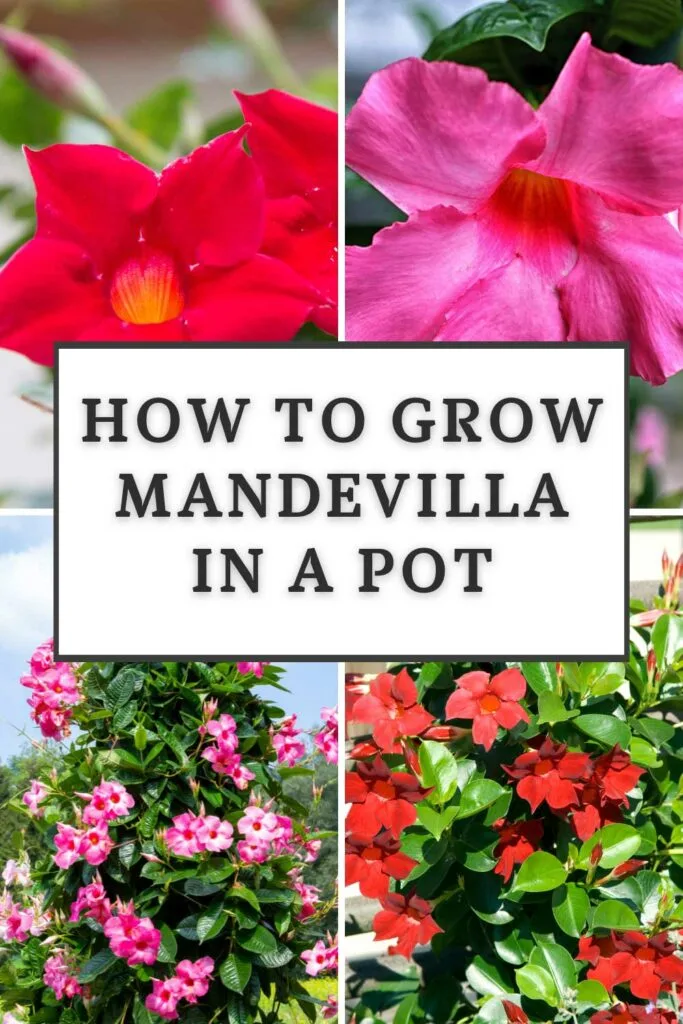
I’ve grown Mandevilla plants in pots for many years, so I will share my insights in this post.
Table of Contents
MANDEVILLA CARE: HOW TO GROW MANDEVILLA IN A POT
The native range for Mandevilla plants spans from southwestern United States, to Mexico and throughout tropical Central America and South America.
The Mandevilla genus contains 177 accepted species. It sometimes goes by the common name, Rocktrumpet, but the genus name Mandevilla is used much more often.
This tender perennial can be grown in the ground year round in frost-free climates. If you live in a colder climate like I do, they’re best grown in pots.
The gorgeous blooms that you will find in hybrid cultivars available for purchase are typically white, pink, yellow and red. The trumpet-shaped flowers appear non-stop with proper care.
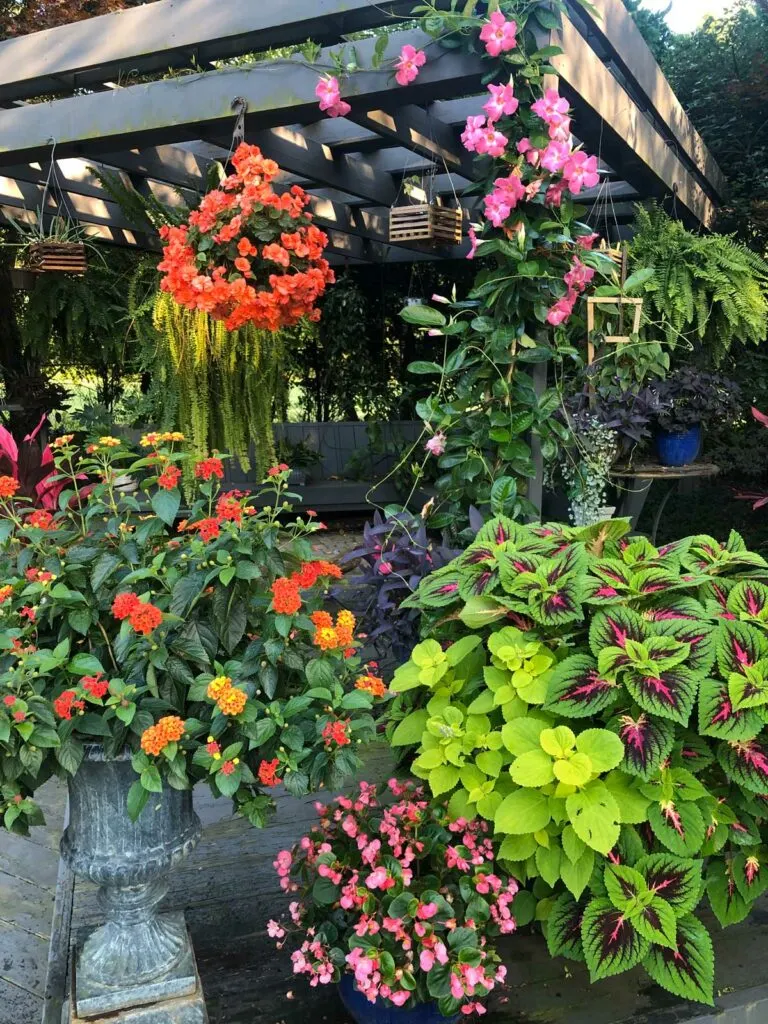
1. LIGHT
In order to get the most abundant flowers, situate your potted Mandevilla in an area with full sun. If you live in an area with very strong sun, partial shade will be beneficial, but provide at least a half day of sun (morning sun is preferable).
If you live in cooler climates where the sun is not at strong, provide as many hours of direct sunlight as possible for best flowering. After all, no one buys these plants for just the foliage!
That being said, I live in Ohio and I’ve had great success with flowering with just half day sun, but they can take more sun where I live. If you don’t provide them any sun at all, you will only get foliage growth and few if any flowers.
Part of the beauty of growing Mandevilla plants in pots is that you can move your plants to an appropriately sunny spot.
2. SUPPORT
There are two types of Mandevilla plants. Most of us are used to the vining varieties, but there are also newer varieties that are “mounding”, so they stay tidy and don’t need a support. The mounding varieties typically stay under 18 inches tall or so.
For the vining varieties, you should provide an appropriate support structure. Many times, when you purchase them, the bigger plants already have a bamboo structure attached or some kind of small trellis so it’s easy to tell if it’s a vining variety.
I have written a blog post showing various structures that I’ve used in my own garden to support these plants. Be sure not to miss my Mandevilla trellis ideas post for inspiration for your own garden.
I’ve used everything from bamboo stakes to clear fishing string to support these vines.
With a little effort, you will create a beautiful focal point for your garden.
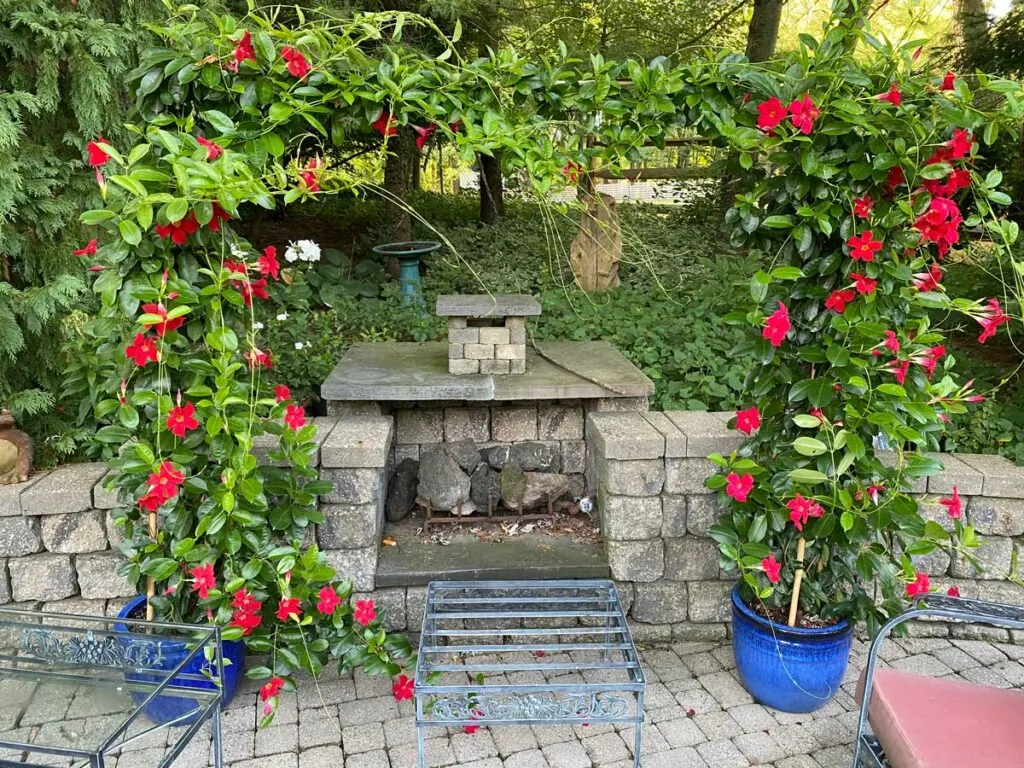
3. WATERING
Mandevilla plants can be prone to root rot if they are kept wet all the time. So be sure to allow your potting mix to dry out a bit before watering again.
I’d recommend feeling the soil with your finger and allowing the top couple inches to dry out out before watering thoroughly.
Never let your Mandevilla’s soil dry out completely. You will quickly get many yellow leaves forming if this happens.
On the flip side, these plants hate wet feet so never, ever allow your pot to sit in water (such as in a saucer below the plant) as this can invite root rot.
4. POTTING MIX
The potting mix that you use is very important for healthy growth of your plant. A well-draining soil is important.
A good mix to use is about 2 parts of an all-purpose potting mix and 1 part either of coarse sand or pea gravel. This will provide the sharp drainage that your plant needs for good growth, and also to help prevent root rot.
Always make sure your pot as drainage holes as good drainage is a must.
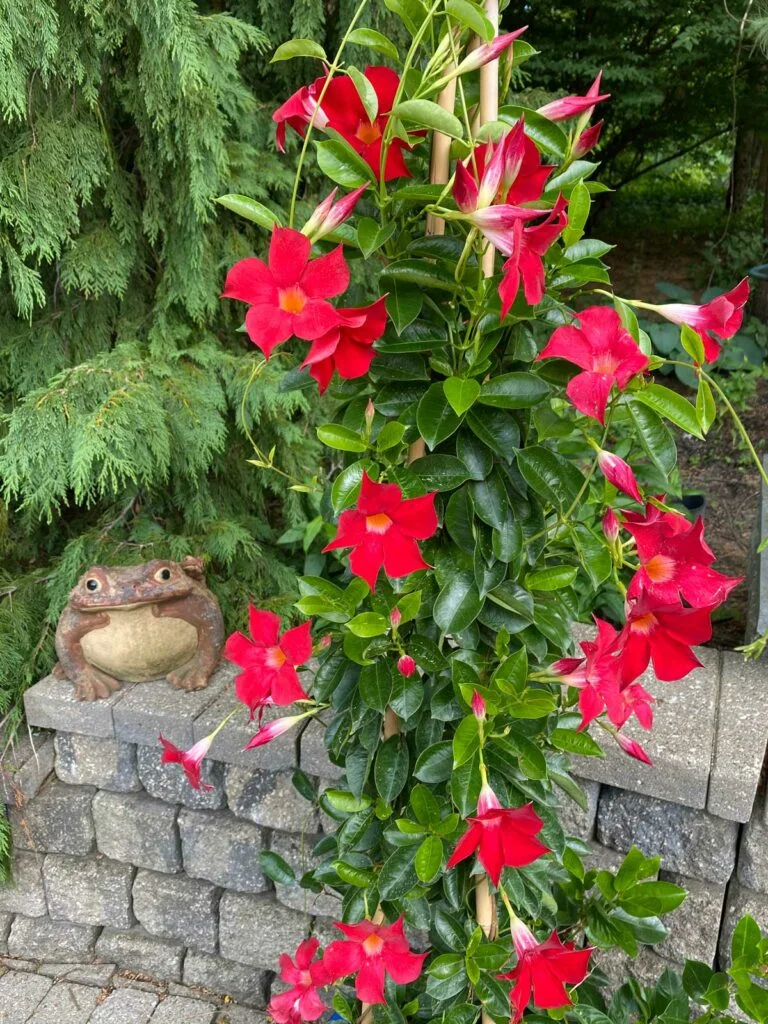
5. FERTILIZING
Mandevillas are very fast growers, so they will need regular fertilization for best results. I like to mix in Osmocote (link to Amazon) into the potting mix. This is a slow-release fertilizer that will provide nutrients every time you water.
I also like to supplement with a water-soluble fertilizer like Miracle Gro Bloom Booster. It contains extra phosphorus to help with more flower bud production.
If you provide your plant with plenty of sun, are attentive to watering, and regularly fertilize, you will have non-stop blooms on your potted Mandevilla throughout the entire growing season.
6. TEMPERATURE
Mandevilla plants love warm temperatures, so resist the temptation to buy them until night-time minimum temperatures are consistently at least 45-50F or higher.
They are said to be hardy in zones 9 and warmer. If you are in colder zones, they will not come back for you if kept in the ground outdoors, but you can of course still grow them in pots and treat them as annuals.
And near the end of this post, I will describe 2 ways to overwinter the plants if you’d like to attempt to save them for the following year.
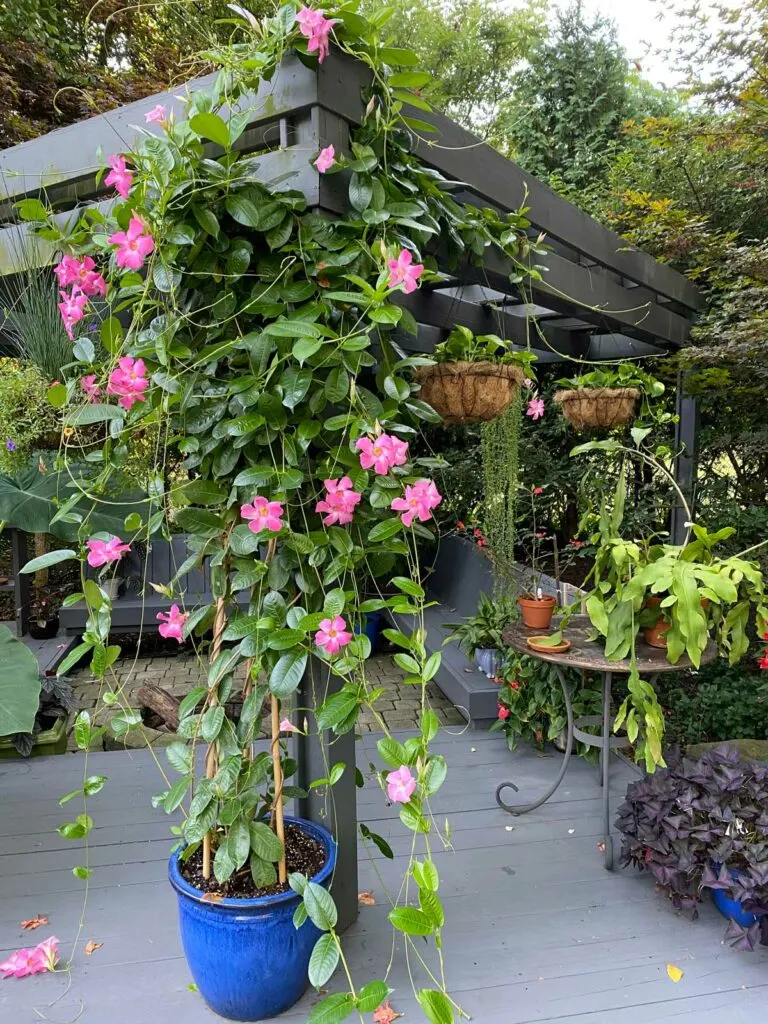
7. PLANT HYGIENE
Because of the abundant blooms, deadheading the flowers is very important. The flowers tend to plaster themselves against the foliage and then become harder to remove and will eventually disfigure the leaves and potentially encourage disease and pests.
As soon as the flowers have wilted, gently remove them so that you can keep the foliage in good condition.
In addition, remove any yellow leaves or diseased leaves if you see any.
Please note that if you happen to prune or break the vines, the plants will exude a white, milky sap that can irritate your skin, so be sure to wash your hands promptly if your skin comes in contact with the sap.
FREQUENTLY ASKED QUESTIONS
WHY IS MY MANDEVILLA NOT BLOOMING?
If your plant is not getting enough sun, this is the primary cause for no flowers. Ensure that your plant receives at least a few hours of direct sun for best results.
HOW OFTEN TO WATER MANDEVILLA?
The frequency in which you water your plant will vary. You shouldn’t go by a strict schedule, but rather, water when your soil has dried out sufficiently.
I recommend waiting until the top inch has dried out for small pots (6 inches in diameter or less), and wait for the top 2 inches of soil to dry out for pots 8 inches in diameter and bigger.
WHY ARE MY MANDEVILLA LEAVES TURNING YELLOW
There are numerous reasons why Mandevilla leaves turn yellow, but the #1 reason that this happens is if you allow your potting mix to dry out completely.
If your soil has gone completely dry, go ahead and give your plant a very thorough watering. The yellow leaves will not turn green again, but it will stop other leaves from yellowing.
HOW DO YOU OVERWINTER A MANDEVILLA VINE?
If you live in a cold winter region, there are two ways that you can keep your plant over the winter months. In the first method, you’ll keep it growing. With the second method, you’ll allow the plant to go dormant.
1. Before cold temperatures start in mid to late Fall, trim off about one-third of the plant, and up to about half of the plant or so. You’ll want to take some pest control measures as well, so give your plant a good spray with an insecticidal soap or horticultural oil.
Make sure you spray the undersides of the leaves as well and coat the entire plant. You may also consider using a systemic insecticide as an additional precaution.
Next place your plant in the sunniest window that you have. Then in mid to late winter, give it another pruning and start fertilizing. This will give your plant a good head start for when you place it back outdoors.
Please note that after you move your plant indoors, it is normal for some of the leaves to fall off or turn yellow. Your plant is simply responding to the reduction in light.
2. If you don’t want to keep your plant growing, you can attempt to let it go dormant and store it during the winter months. When temperatures outdoors start to dip below 45°-50°F (7°-10°C), go ahead and prune your Mandevilla vines back and leave only about 12 inches of vine.
Place your pot in a cool, dark location (around 50°F/10°C or so). Even though you’re letting your plant go dormant, you will still want to water the soil periodically. If you keep the soil bone dry all winter, your plant will dry out and die.
In late winter or early spring, place it in front of your sunniest window, and when temperatures are appropriate, you can move your plant outdoors.
Keep in mind that whenever you move any plant outdoors, you must place your plant in full shade FIRST for a period of a few days in order to acclimate your plant. Then at that point you can introduce some direct sun a little at a time.
If you don’t do this and place your plant immediately into full sun, your plant will quickly burn.
I hope you’ve enjoyed this post on how to grow Mandevilla in a pot. Have you tried growing this plant? Comment below. I’d love to hear!
If you’ve enjoyed this post, you may also enjoy my post on plants that bloom all summer long.

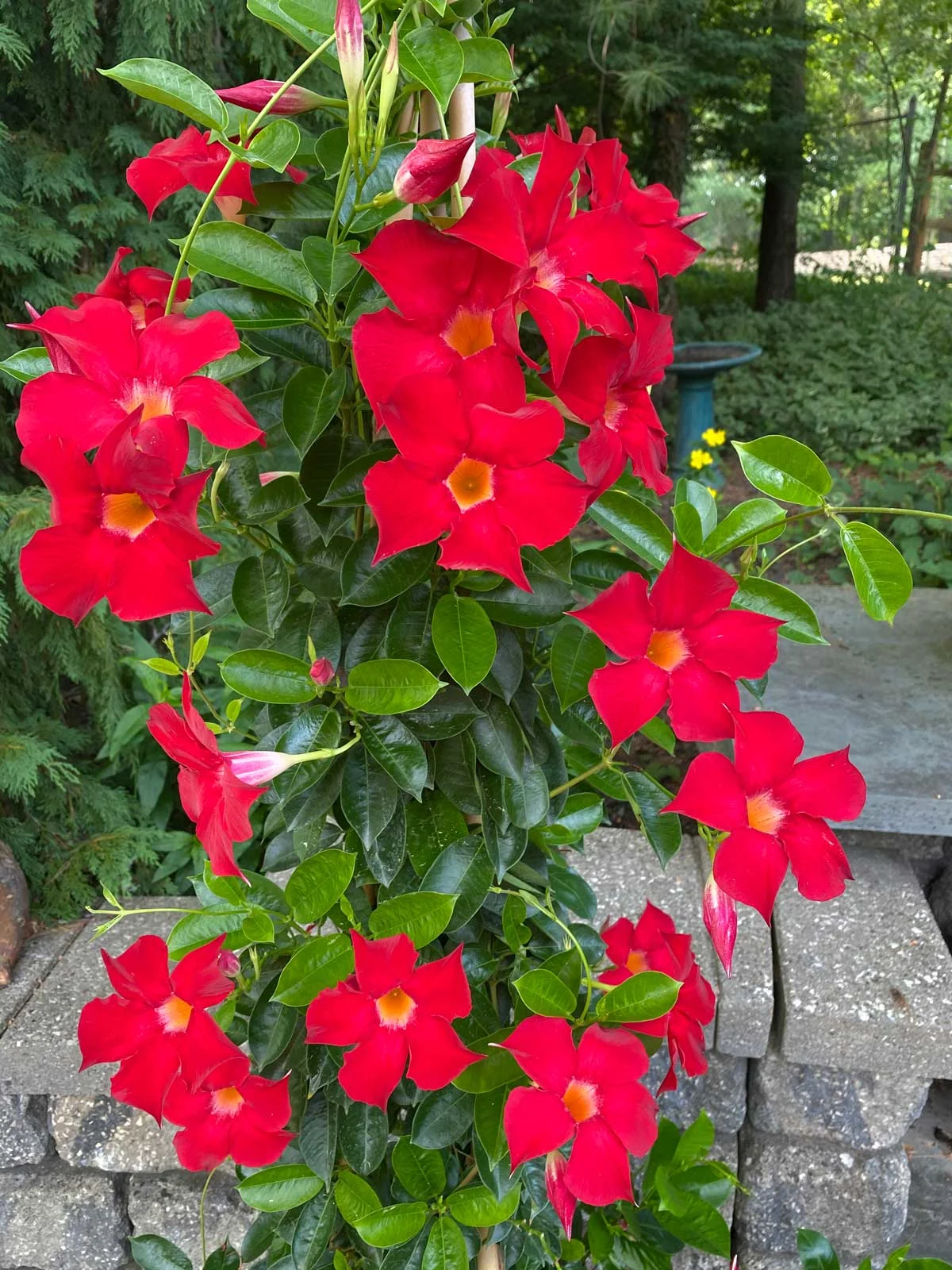
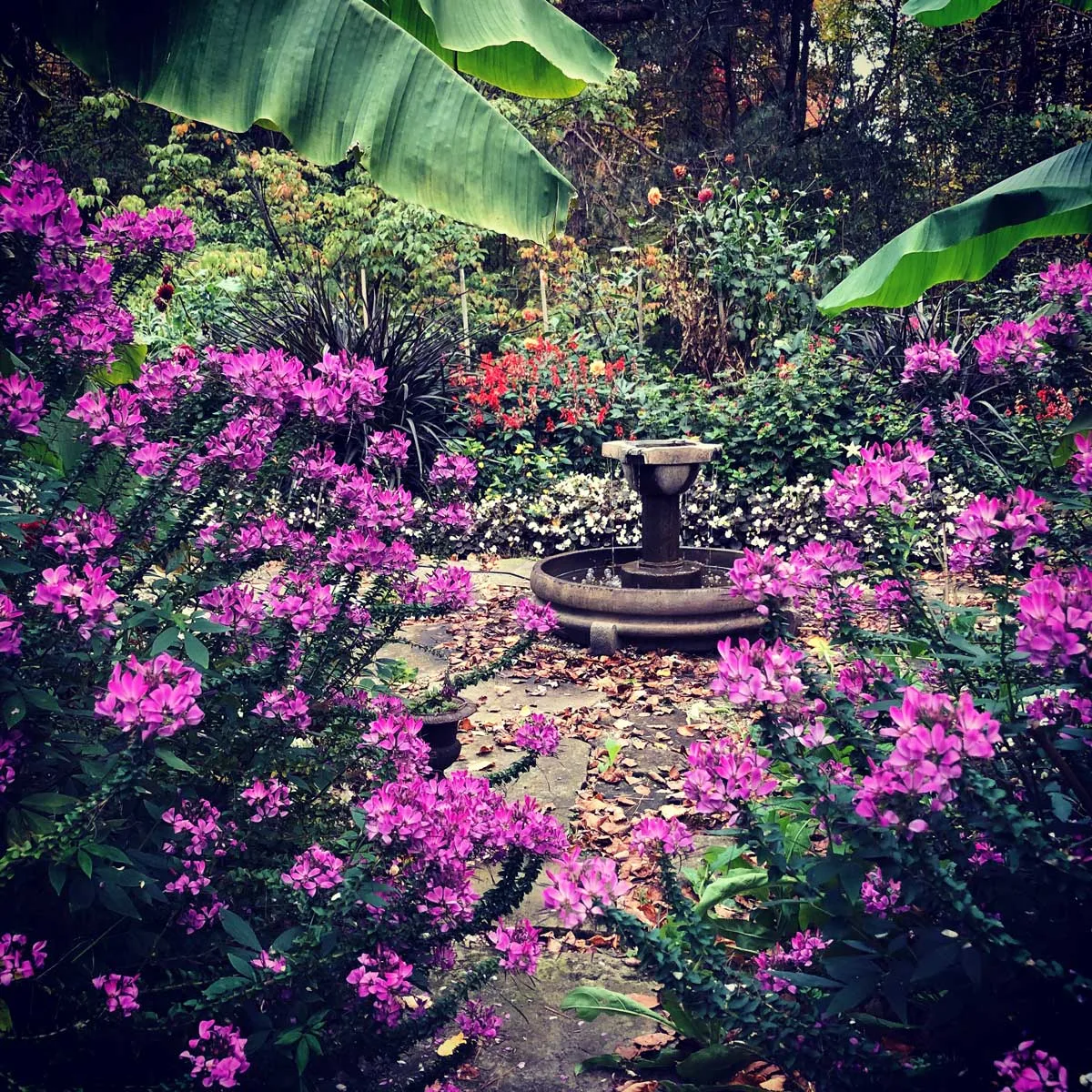
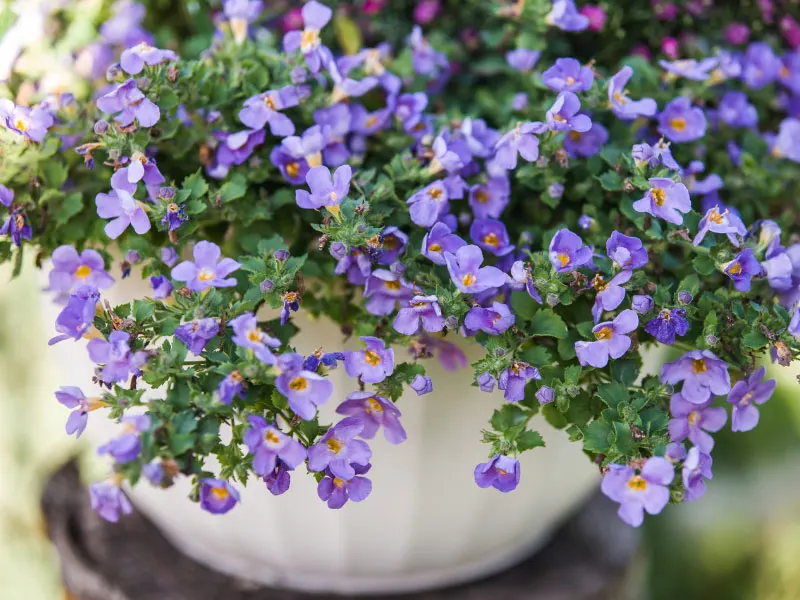
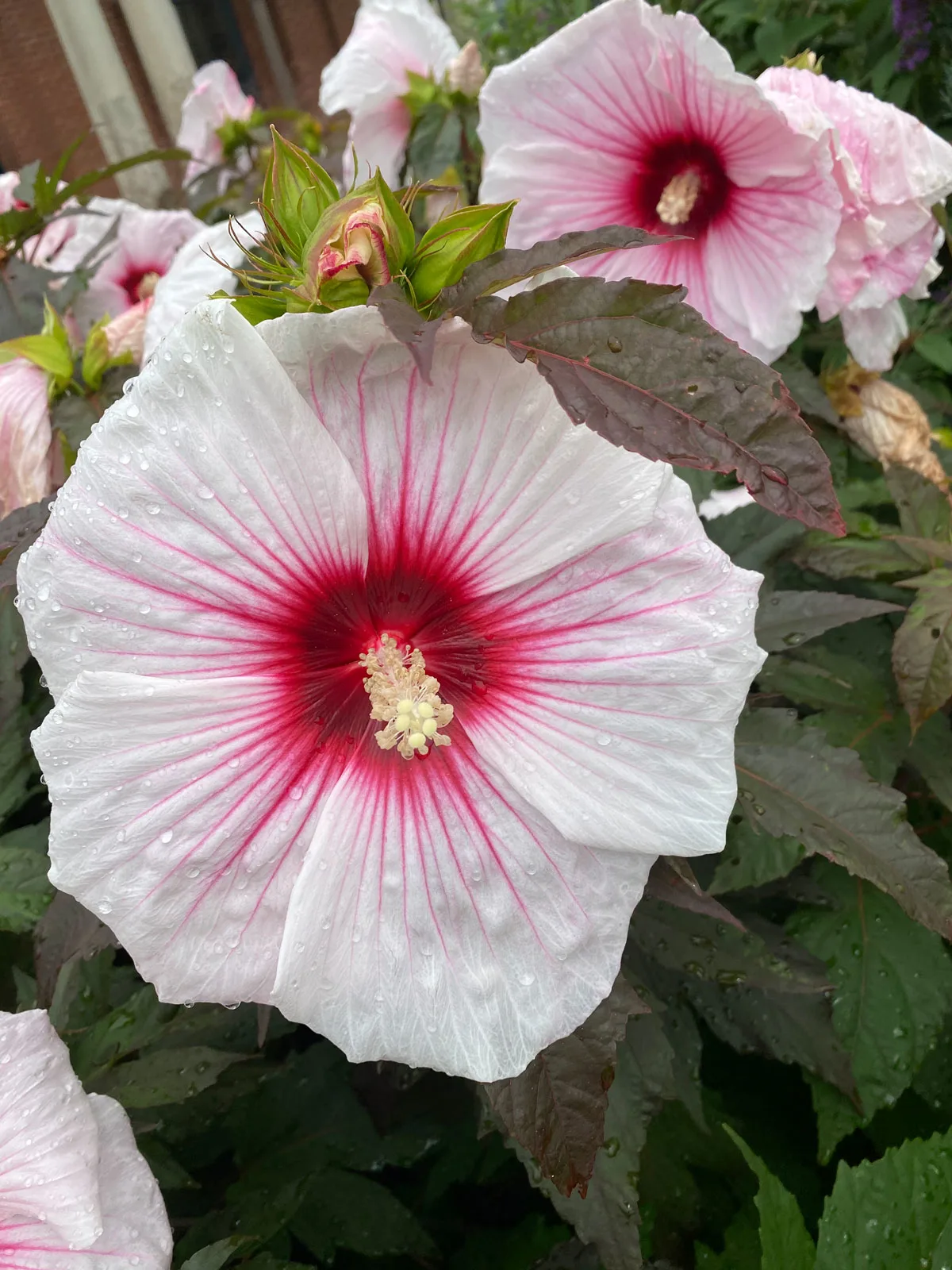
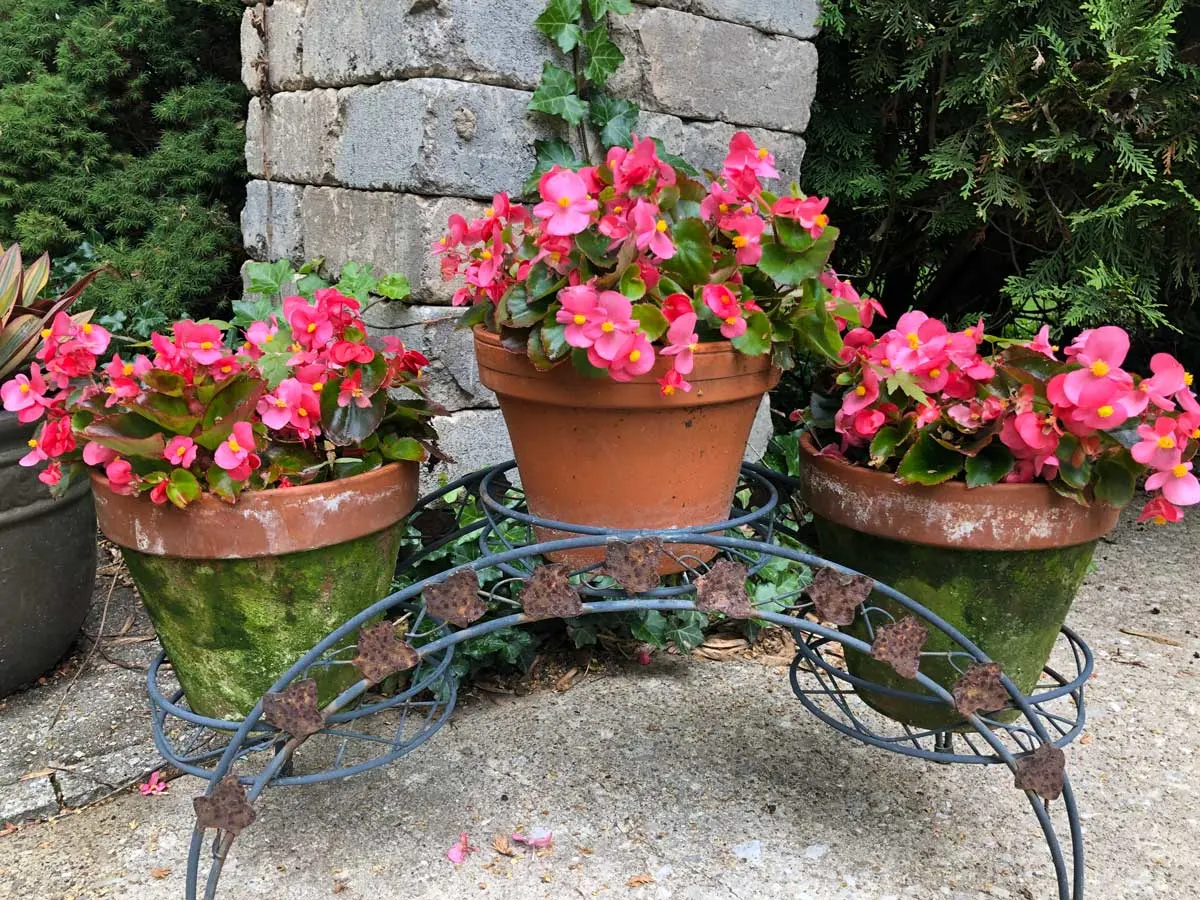
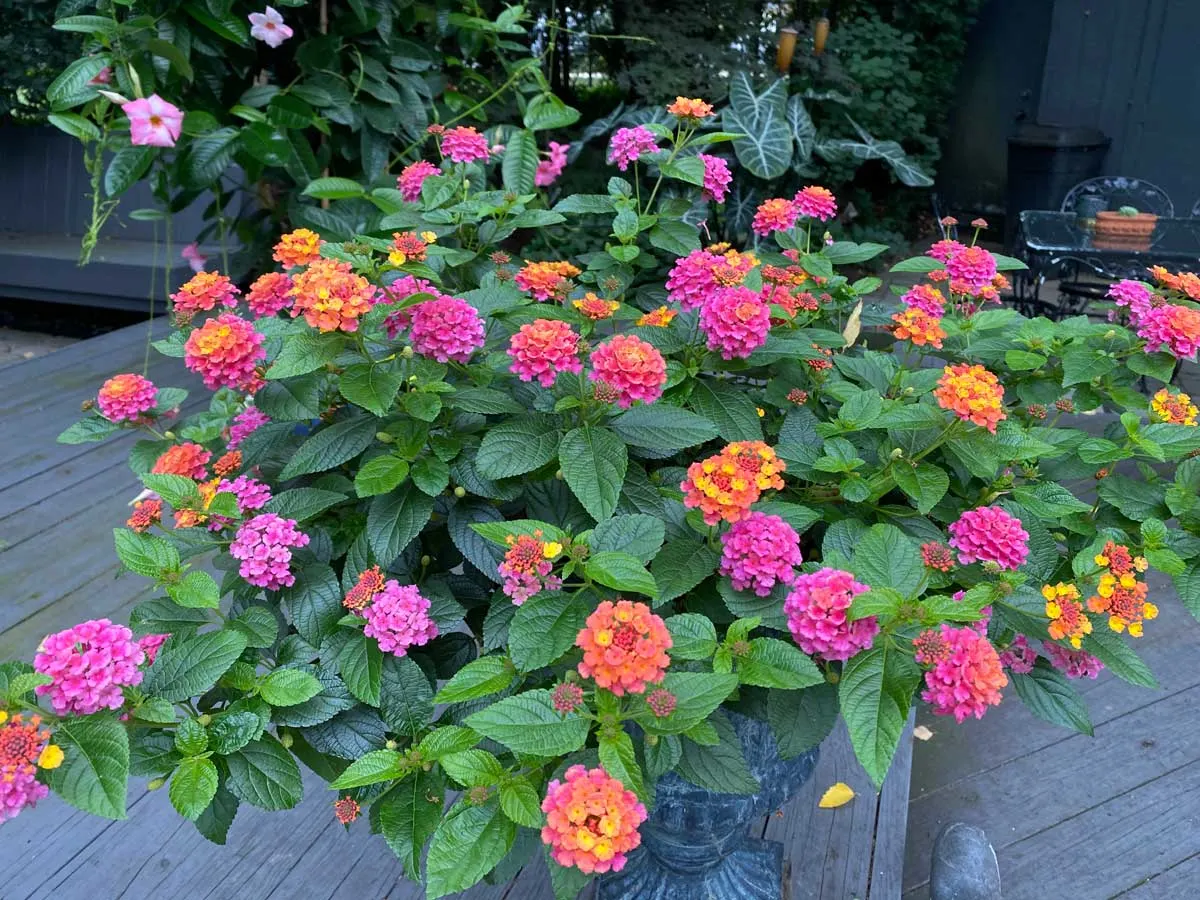
Pat
Tuesday 6th of May 2025
Can I just cut off the thin vines and have a bushy plant. Sorry IA changes my text.
Raffaele Di Lallo
Wednesday 7th of May 2025
If it has other vines, it won't hurt to cut off the thin ones.
Pat
Tuesday 6th of May 2025
Bought Mandevilla by mistake. Wanted Dipledemia. It has three stakes but only about 18 inches high. An injustice cut off the thin vines that are creeping and have a bushy Mandevilla
Richard Hollis
Monday 28th of April 2025
I planted Mandevilla’s for 30 years. Love it on my deck. It’s absolutely gorgeous. Thank you for all your excellent information. Can’t wait to see you this year.
Raffaele Di Lallo
Thursday 1st of May 2025
Glad you are enjoying my content Richard!
Mary V. Smith
Thursday 18th of April 2024
Just finishing planting a beautiful pink Mandevilla in a pot on my patio! It is just loaded with blooms. I’m in Central Texas so it should thrive. Wish we could download pictures. Your article was extremely helpful…THANK YOU🌺
Raffaele Di Lallo
Saturday 20th of April 2024
Glad you enjoyed the post Mary! Good luck with your plant :-)
Judy
Sunday 25th of February 2024
My Mandeville just puts on long vines but no blooms I try not to over water. The plant has beautiful green leaves . I fertilize on a regular basis. Why does it just vine with no blooms. When it did bloom they curled backward.
Raffaele Di Lallo
Monday 26th of February 2024
Do you have in indoors or outdoors? Where do you live? Did you have it dormant prior to this?